Mercury in the ecosystem; what a threespine stickleback can teach us
by Ted Kincaid |
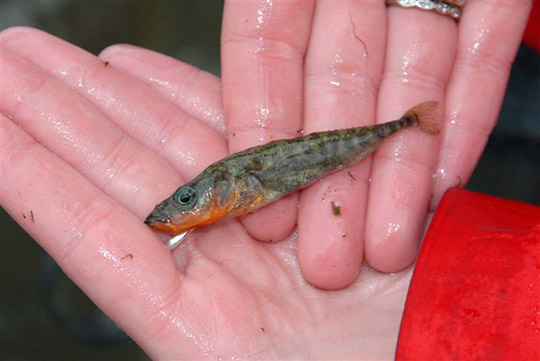
Pay a visit to Frank von Hippel's lab and you might find undergraduate biology students and lab employees Nicole DeLuca and Maio Nishkian preparing threespine stickleback for stable isotope analysis. On grinding days, they're grateful for help from the "angry penguin," a cryogenic mill that makes short work of pulverizing a specimen, a job that once had to be done by hand. Don't forget to don your hearing protection-the thunderous fwapfwapfwapfwapfwap-ing of the machine in motion is deafening. Angry penguin, indeed.
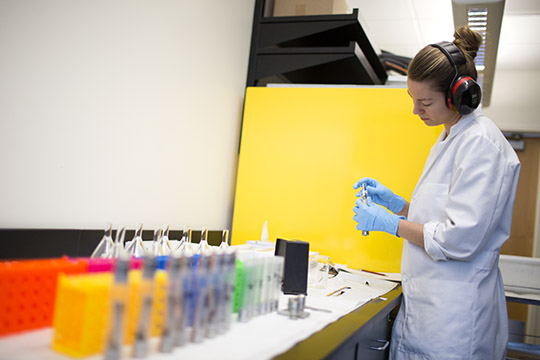
Nicole DeLuca, an undergraduate researcher and lab assistant in the von Hippel lab,
prepares samples for the cryogenic mill.
From the grinding room, samples get sent to the tinning room for careful packaging in tiny tin pellets-a job that's done entirely with forceps and endless patience. Experience speeds things up. "I can do a tray in about 45 minutes," says Ph.D. candidate James Willacker. Someone new to the task can spend about four hours. The tiny pellets are then fed into an elemental analyzer and then the isotope ratio-mass spectrometer for stable isotope analysis, which will tell researchers what their fish have been eating in the last month or so. "Basically, you are what you eat," says Kyle Shedd, a biological sciences master's student. "You're carbon and nitrogen. That diet leaves a signature in your body tissues." And that diet just might include a little mercury.
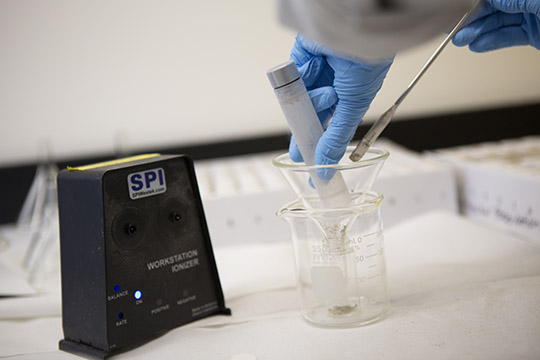
Ground up threespine stickleback headed to the tinning room
Professor Frank von Hippel, Ph.D., a faculty fellow with UAA's Environment and Natural Resources Institute (ENRI), is working with graduate students, professional colleagues and a network of international scientists and laboratories in western North America to study mercury in aquatic food webs.
"In biology research there's no such thing anymore as research that's a single lab. It's all collaborative nowadays. Projects are so complex that one person can't do it all," says von Hippel.
Recognized as a global issue by scientists around the world, the International Conference on Mercury as a Global Pollutant convenes this year in Edinburgh, Scotland. Von Hippel and Willacker will be attending. Gaining momentum from a new U.N. environmental initiative, this year's conference is organized around the theme, "Science informing global policy."
Mercury in the aquatic food web is just one of several research projects for von Hippel, a conservation biologist, evolutionary biologist and ecotoxicologist who came to UAA in 2000 after teaching at both Columbia University and University of California, Berkeley, where he earned his Ph.D. Much of his current research relies on a small, unassuming fish as a model: the threespine stickleback. To the untrained eye peering into an Alaska lake, it's a minnow. To biological researchers like von Hippel, it's the most ecologically important forage fish in Alaska. And it's helping them learn how mercury moves through the food web-the trophic ecology of mercury.
Mercury-both imported (made in China) and local (made in Alaska)
"Mercury is a neurotoxin that causes damage to the developing nervous system, to the
brain," explains von Hippel.

View of Denali from a lake field site near Talkneeta
You'll find mercury in more than just glass thermometers in Alaska. "It's a widespread contaminant that's liberated when we burn coal and other fossil fuels so it gets into the atmosphere and settles out in different parts of the world, including here in Alaska," he says. "We receive a lot of mercury from the burning of coal in China." But that's not all. Mercury is also a natural element. Alaska has historically had mercury mining since a portion of the mercury belt running through North America created deposits here in Alaska. Volcanic eruptions, which Alaska is no stranger to, are also responsible for emitting mercury into the atmosphere.
Mercury bonds strongly with protein, so once it enters the food web, it has some serious staying power. "Mercury both bioaccumulates-it appears at higher levels in animals as they grow older-and it biomagnifies, so the higher up on the food web you go, the greater the mercury levels," says von Hippel.
Another fast fact: you'll often find more mercury in the ocean than in fresh water. But don't go emptying out your fish freezer. Von Hippel and his graduate student researchers are quick to point out that Alaska's wild salmon stocks-all five species-are a healthy choice for your dinner plate. Salmon shark on the other hand, you might want to reconsider. And that expensive tuna on the sushi menu? You may want to make sure that's just an occasional treat.
Don't trust the canaries-rely on a survivor like the stickleback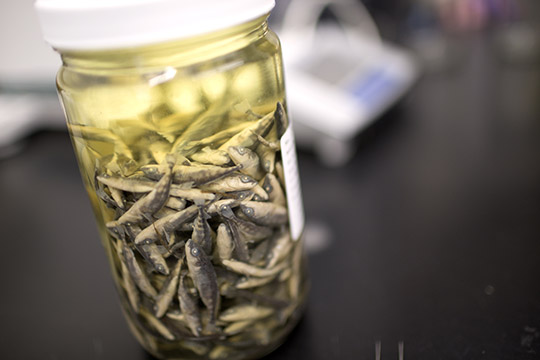
Everyone knows about the canary in the coal mine. Used by miners as an early warning system for carbon monoxide, the canaries are the first to kick off when levels start to get dangerous. The threespine stickleback is valuable to researchers for the opposite reason.
"Stickleback are really very tough fish; they're the last ones to die, not the first ones to die," says von Hippel. "They have many advantages that allow us to study the biology of contaminants. One of the advantages is that they survive well. If an animal dies right away, then you can't figure out what contaminants are doing to their physiology or how their gene expression is changing because they die before they get a chance to show those things."
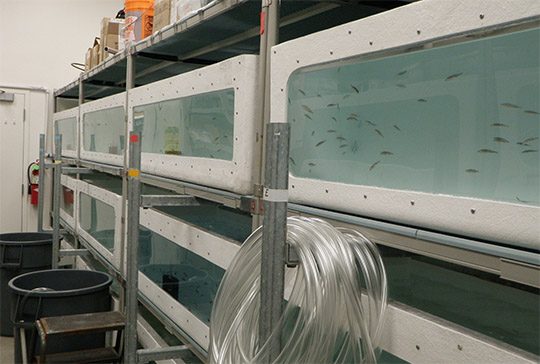
Captive threespine stickleback in the ENRI fish room
The other major advantage to using stickleback as a model? They're a well-understood species. Like students testing out of prerequisites, researchers can blaze right past the basic biology of the fish in favor of advanced studies. With its sequenced genome, researchers are able to track the genetic effects of contaminants like mercury. "We also have biomarkers for stickleback that aren't available for most other animals so we can see how the contaminants, like mercury, are interrupting the hormonal system," says von Hippel. All that and they're found in both fresh and marine waters, are relatively easy to collect and can be raised in the lab in large numbers for captive studies. Like humans, the stickleback also have XY-chromosome sex determination.
Want a clever way to bring up sex at your next cocktail party? Try this. Sex is always determined by those X- and Y-chromosomes, right? XY=male and XX=female. True for humans. And stickleback. But most birds do it with a ZW, where the double-Zs designate male. And in sea turtles, sex is determined by temperature during incubation. The take-home lesson? Spend some time with UAA's scientists and you'll never lack for a conversation starter.
The who's who of mercury research in the von Hippel lab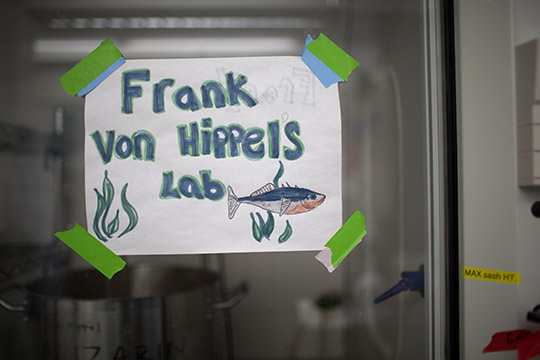
Von Hippel is quick to direct attention to his graduate students whose names you'll find beside his on recent scientific journal publications. They are working on what he terms "nested" research projects that fit together to paint a detailed picture of mercury in Alaska ecosystems. Von Hippel works closely with UAF professor Todd O'Hara and they, along with their students, collaborate with the U.S. Fish and Wildlife Service (USFWS), the U.S. Geological Survey and the National Park Service (NPS).
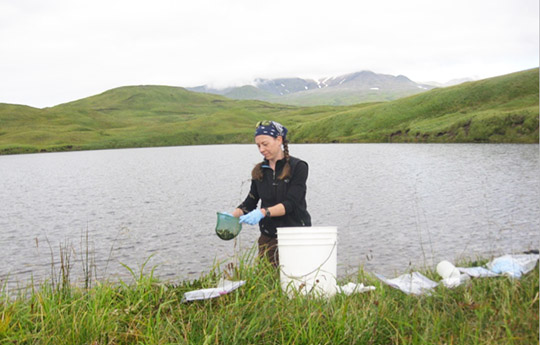
Leah Kenney collecting fish at an Aleutian lake on Adak Island
Leah Kenney has been working with ENRI and von Hippel since 2009. She came to UAA to pursue a graduate degree in biological sciences, graduating with her M.S. in 2011. She is currently a biologist for USFWS, but continues to work with von Hippel on projects relating to her master's research, studying mercury in the food webs of Aleutian archipelago lakes. Von Hippel and Kenney examined lakes near formerly used defense sites-military dump sites-and compared mercury levels in the threespine stickleback to those of the fish in lakes frequented by seabirds. The fish in lakes with high seabird use-foraging, preening, defecating-had significantly higher levels of mercury than fish in the lakes near contaminant sites. What does that suggest? "The biotransport of mercury appears to be more important than the military contribution," says von Hippel. Seabirds, as apex predators in the ocean, can consume and retain a lot of mercury. So while the lakes' feathered visitors appear to travel light, they're actually packing some heavy metal.
Kenney and von Hippel have expanded the scope of Kenney's master's research and are now looking at environments from Russia through the Aleutian archipelago and into southcentral Alaska. They're modeling sources of mercury using both stickleback and Dolly Varden.
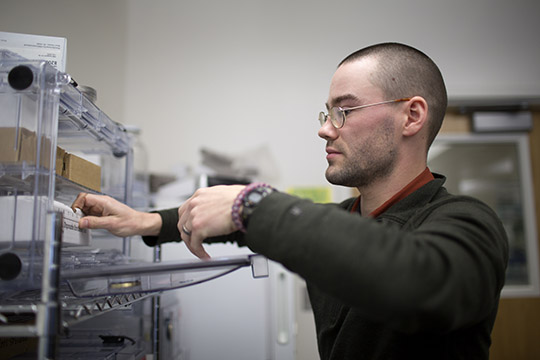
James Willacker, Ph.D. candidate, at work in the von Hippel lab.
James Willacker came to Alaska from New York in 2007 to work with ENRI and attend UAA as a graduate student. He connected with von Hippel while working on a national lake survey funded by the EPA to assess the quality of lakes in the country. He earned his M.S. with von Hippel in 2009 and is currently working toward a Ph.D. through UAF with von Hippel as his Anchorage advisor and O'Hara as his Fairbanks advisor. A familiar face in the bustling ENRI labs, Willacker has become the resident expert on two types of threespine stickleback, those that live and feed in the benthic (bottom and near-shore) areas and those that live and feed in limnetic (deeper, open-water) areas.
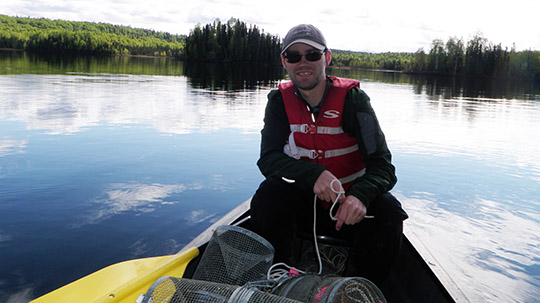
Willacker on Benka Lake with minnow traps.
One of Willacker's field sites, Benka Lake near Talkeetna, is the only known freshwater home to both benthic and limnetic stickleback in Alaska. In studying how mercury moves through the lake's benthic and limnetic food webs, Willacker, O'Hara and von Hippel have learned some important lessons. Mercury concentrations are higher in the limnetic, open-water fish. And females of both the benthic and limnetic stickleback consistently have less mercury than males.
Findings like that mean Willacker has a lot of irons in the fire; his research results beg second, third and fourth questions. Are there seasonal differences in mercury levels among the fish? Is mercury more heavily concentrated in certain tissues? Answering questions keeps him on the go between the ENRI labs and field sites throughout the Cook Inlet Basin.
You'll notice a common trait among von Hippel's graduate students. In addition to being smart, dedicated researchers, they're also all avid fishermen. Handy, since catching fish, big and small, is all in a day's work in the field.
"I was with one of my field technicians this summer and we would go out sampling all day and then eat dinner and he'd go back out fishing again because he liked it so much," says Kyle Shedd. "He'd come back at 10 and say, 'hey, I caught some more samples,' and we'd say, 'okay, we're ready to go to bed, Bob, but let's process those.'"
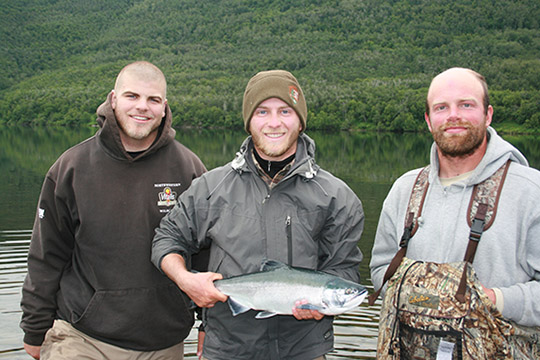
Kyle Shedd (center) with "Team Kokanee" researchers at Jo-Jo Lake in Katmai National
Park.
Shedd first came to Alaska in 2007 from Illinois's Northwestern University to work as a biological technician for a summer at Katmai National Park. It was through his summer work in Alaska for the NPS (he's worked five seasons in Katmai) that he eventually connected with von Hippel and decided to come to UAA for his master's degree.
Shedd's research at Jo-Jo Lake in Katmai National Park has him looking at the whole aquatic food web, from baseline consumers like freshwater snails and mussels on up through larger species like kokanee-landlocked salmon-and northern pike. The northern pike, as a long-lived top predator in freshwater systems, has the highest levels of mercury.
Implications for human health and conservation
So, just what are the practical applications of the von Hippel lab mercury research? Fish in Alaska are both ecologically and economically important and mercury is the primary pollutant of fish. "Almost all fish advisories, where fish are unsafe to eat, have to do with mercury," notes von Hippel.
Understanding how mercury moves through the food web has important implication for both human health and wildlife conservation.
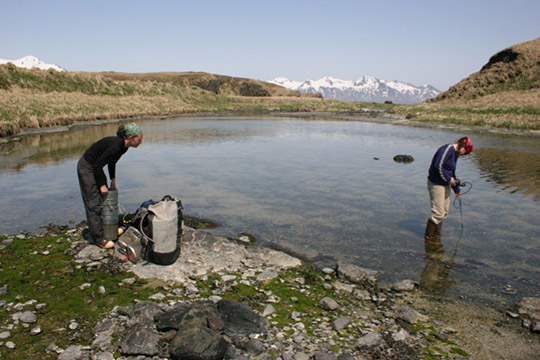
Leah at another Aleutian field site on Attu Island
"In the Aleutians, for example, almost every forage fish has higher levels of mercury than are recommended for consumption," says von Hippel. "They're not enough to be a problem for people, but they're high enough to be a problem for the animals that eat them, huge amounts of them, day in and day out. I've seen seabirds eat hundreds of stickleback in about 15 minutes and they're doing this constantly."
While tackling global industrial emissions-the human contribution to mercury pollution-may be a little outside the realm of scientists studying ecotoxicology, Willacker sums up the far-reaching purpose of the von Hippel team's nested research nicely: "Ultimately, we hope that what we're doing informs the science that goes into policy."
 "Mercury in the ecosystem; what a threespine stickleback can teach us" is licensed under a Creative Commons Attribution-NonCommercial 4.0 International License.
"Mercury in the ecosystem; what a threespine stickleback can teach us" is licensed under a Creative Commons Attribution-NonCommercial 4.0 International License.














